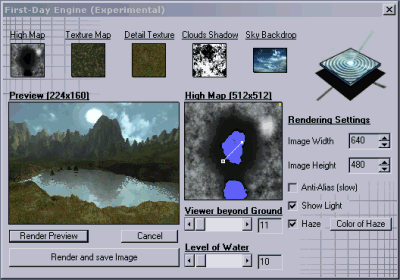 |
Advanced functions |
 |
Advanced functions |
| I-Tex offers you useful
additional functions, which are explained here.
Texture Preview
Using this preview you can explore how your texture might look when used in a 3D program. You have the following possibilities : Isometric Bump Preview : Here the texture is displayed in an isometric voxel space. The heights can be determined by the texture itself or the source. Spherical Preview : This preview shows the texture drawn on a sphere. You can deactivate the background for better results if you want to save the sphere. Plasma Rendering : Some textures look boring if you tile them on your desktop or a web page. Using this function your texture will be tiled and blended with a plasma. Press expand to adjust the size of the output image. Plane Preview : This function draws the texture on an infinite plane. Use expand to adjust the size of the output image.
Color Gradient Designer
The color gradient designer is used to replace
the texture's colors with a color gradient. Also, the generator engine
can operate with a color gradient. A color is defined here by its hue,
brightness and saturation. The three designer windows can be configured
independently of each other. Activate lock at the top of a designer
to force every point to the same height on changing. Use reset to
set the designer to its original state. Blur makes the gradient
smoother, and
randomize creates a random gradient.
Texture Library
The texture library (archive) is a powerful utility
to manage your textures. All textures will be stored in the texlib
sub directory of I-Tex Tand can be accessed through a tree view. There
you can select and open a texture contained in the library. The scan
button reloads the library and also caches it for faster access. Use flush
to empty the cache. By using the compress button you can convert
textures into space saving JPEG image files. The
new button will
create a new sub directory within the library.
First-Day Engine  This feature is for professionals who want to see how their textures and highmaps look when used in game development or 3D rendering. The engine is a simple raytracer which allows - a high-map, which is used to define mountains
and valleys
You can place the viewer (thick white) and define the position of a single light source (yellow) to keep things simple. (The landscape will be rendered using gouraud-shading, shadows and haze.) |